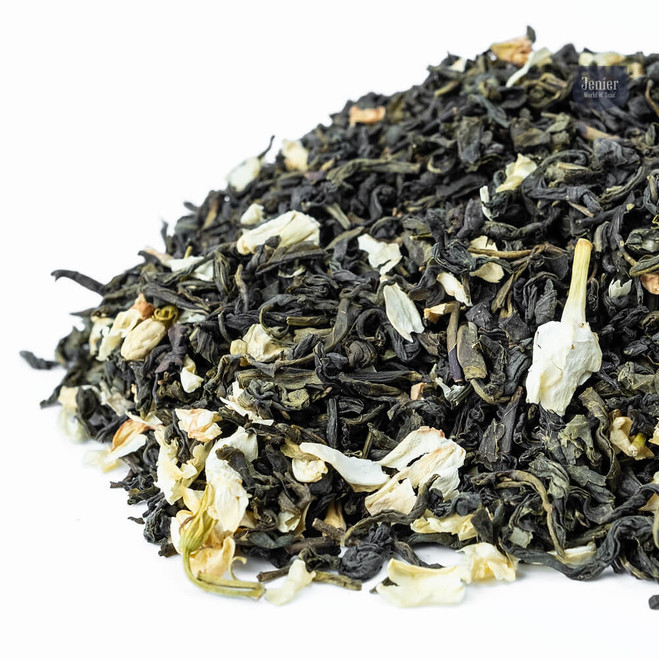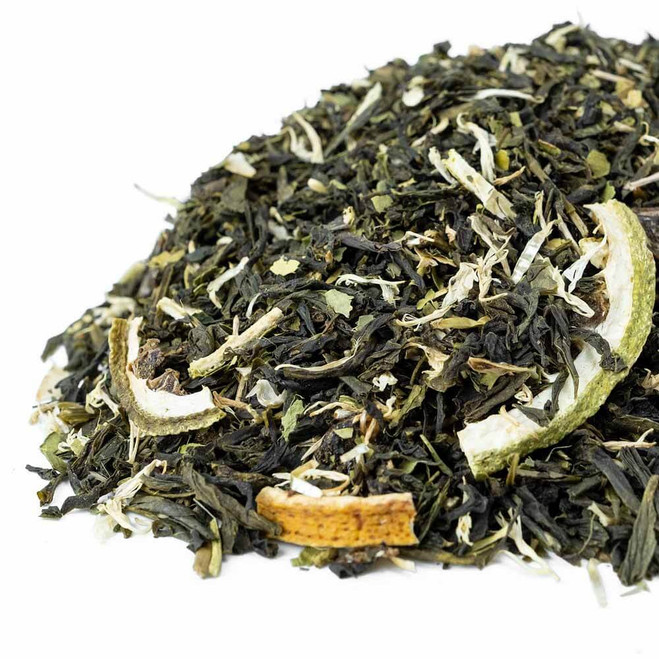-

Gin & Tonic Green Tea Blend
£34.09 -

Gunpowder Mint Green Tea
£24.77 -

Gyokuro Green Tea
£101.25 -

-

-

Jasmine Blossom Green Tea
£24.00 -

-

-

Lemon & Lime Green Tea
£23.28 -

Lemon Gunpowder Green Tea
£24.87 -

-

Wholesale Loose Leaf Green Tea From Around The World
Select from our range of loose leaf green teas from different growing regions around the world. All our teas are picked at peak season and carefully stored to retain freshness and flavour. There are many types of green tea to choose from and of course you can sample any of our teas - just check out How To Order Wholesale Loose Leaf Green Tea Samples
Learn More About Loose Leaf Green Tea
Learn More About Loose Leaf Green Tea
What is green tea, and why is it so popular?
Green tea is popular today as it was thousands of years ago when legend describes how tea leaves blew into a pot on his stove and a Chinese Emporer made the first pot of tea! But what is green tea, and why is it so popular?
Firstly, to understand what green tea is, we must recognise that the tea leaf's processing determines if it will become white tea, green tea, oolong tea, or black tea. All tea leaves start as leaves growing on a tea bush. The way tea estates and tea masters process the leaves determines their type.
How is green tea made?
As tea is grown worldwide, there are many different tea-making techniques that tea masters use. These techniques yield different leaf shapes and flavours, but one standard process is the application of heat to stop the oxidation of the leaves. Oxidisation is a chemical reaction that causes tea leaves to turn brown, a process seen in the manufacturing oolong and black teas. When making some of the best green teas, the leaves are hand-plucked from the tea bush after the leaves are fully open. Sometimes the plucked leaves are left to wither for a short while before heat is applied to make green tea. The temperatures used at this point in the process are very high. Once finished, the green tea leaves are rolled or pressed by skilled tea makers, and their unique flavours develop before they are dried and sorted.
Choosing Your Loose Leaf Green Teas
Green Tea Leaves are amazing in both their varied forms and the health benefits they provide. For the purposes of everyday serving, 3 - 5 cups of green tea a day is associated with health benefits, but which one should you choose? As the chemical structure of a green tea leaf is likely to be very similar from one to another, we would say the teas you should choose should be ones you really enjoy! You'll see from the category of loose leaf green teas, they can look (and taste) very different so it really is a good idea to sample and taste a good range. You'll find individual descriptions about each tea on their product page along with more detailed information about where grown, tasting notes etc. on the Product Profile tab shown next to the tea description. If you'd like to learn more about the health benefits of green tea visit: Health Benefits of Green Tea
Introducing green teas from around the world.
As with most tea-growing regions, China has provinces where the quality of teas is among the best in the world, including Hunan, Yunnan, Fujian and Anhui, and it is from these regions we source our Chinese green teas. Chinese green teas often have descriptions in their name that relate to the shape of the finished tea leaf. For example, in the name of the tea, Chunmee Taipan Superior, we understand by using the word Chunmee that the shape of the green tea leaf is an 'eyebrow' shape.
Another popular leaf shape is 'pinhead gunpowder', also known as Pingshui green tea. The term 'gunpowder leaf' is attributed to the description made by an English clerk who, at first sight, thought they were gunpowder pellets! With this type of leaf, green tea leaves go through a rolling process to become like tiny balls and make a strong, dark green infusion.
As green tea's popularity spread worldwide, countries like Japan, Sri Lanka and Kenya began to grow and make green tea using traditional methods and developing some of their own. One such development is the Japanese sencha-style leaf. The green tea leaves are steamed and pan-fried, which results in the finished leaf having a distinctive flat, glossy look. The Japanese method of green tea production is also used in Kenya, as seen with Kenya Kosabei Sencha Green Tea resulting in a sencha-style leaf that is both light and smooth.
Japanese tea makers place tea bushes under black cloths or bamboo shades to increase the level of chlorophyll, the chemical in the leaf that gives it a green colour, to make one of the most sought-after green teas known as Gyokuro. Gyokuro is a tea with very dark green leaves and lower levels of tannins. When infused, the darker green leaves give a sweeter flavour with no bitterness and are one of the most prized green teas you could enjoy.
How To Infuse Loose Leaf Green Tea
If you've ever tried green tea and been put off because it tasted really bitter, the chances are the water temperature used to infuse the tea leaves was too high or there was too much green tea for the volume of water (having too much tea for the volume of water used can make any tea taste bitter, not just green tea). So don't be put off! Great quality loose leaf green tea when infused properly is so sweet and delicious and definitely a tea to include on your tea menu.
As with all tea infusions, we start with water. Wherever possible, use fresh, filtered water. The water temperature to use should not be boiling but around 80 Degrees. Infusion times for green teas are also less than for larger leaf black teas within a range of 1 - 4 minutes, but for a medium strength we would suggest around 3 minutes in general.
If you'd like to learn more about Green teas and food pairings, check out our post at the Tea Hub: Tea And Food Pairing

